Breaking the press
This session is about developing a team to build play successfully against a variety of pressing strategies, looking at goal kicks and open play scenarios.
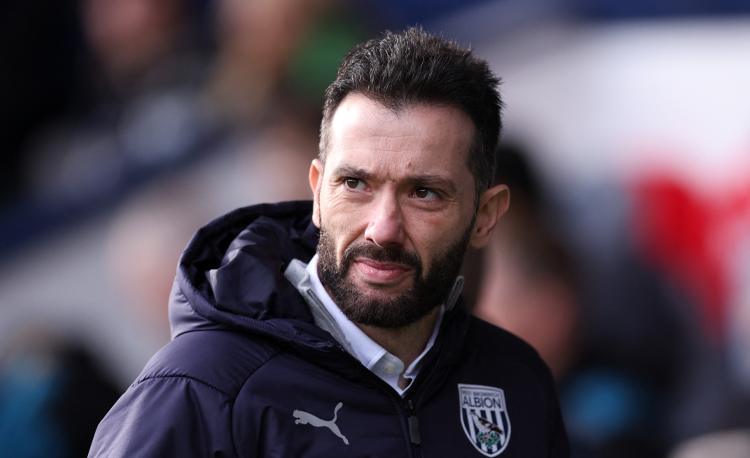
| Area |
Full pitch |
| Equipment |
Full size goals, mannequins, cones, poles, mini goals, flat markers |
| No. of Players | 22 + GKs |
| Session Time |
Positional split: 12mins Double-box game: 20mins Split phase of play: 20mins 11v11: 30mins |
This session is about developing a team to build play successfully against a variety of pressing strategies, looking at goal kicks and open play scenarios. The tactical focus is to create a spare player and use this to our advantage, and then progress to build up against a player-for-player marking system.
This session has a direct correlation to the 11v11 modern game, and players can link their understanding from matchday to the training session. We use analysis and iPads throughout to bring the scenarios to life and to connect players to the practice through emotional attachment from their recent game experiences.
We would run this session once per week. Our ideas will depend on how our next opponents set up. The key is to prepare the players for all types of scenarios they may face. Adaptations to the pressing, players, area size, scoring systems, physical requirements and so on are all considerations.
POSITIONAL SPLIT
In the first practice, we split by positions. In the primary practice, eight defenders and four midfielders work with a focus on finding the spare player to break the press. In the secondary practice, ten attacking players work with a focus of regaining the ball with pressing, to attack and score quickly past the goalkeeper [1].
[1]
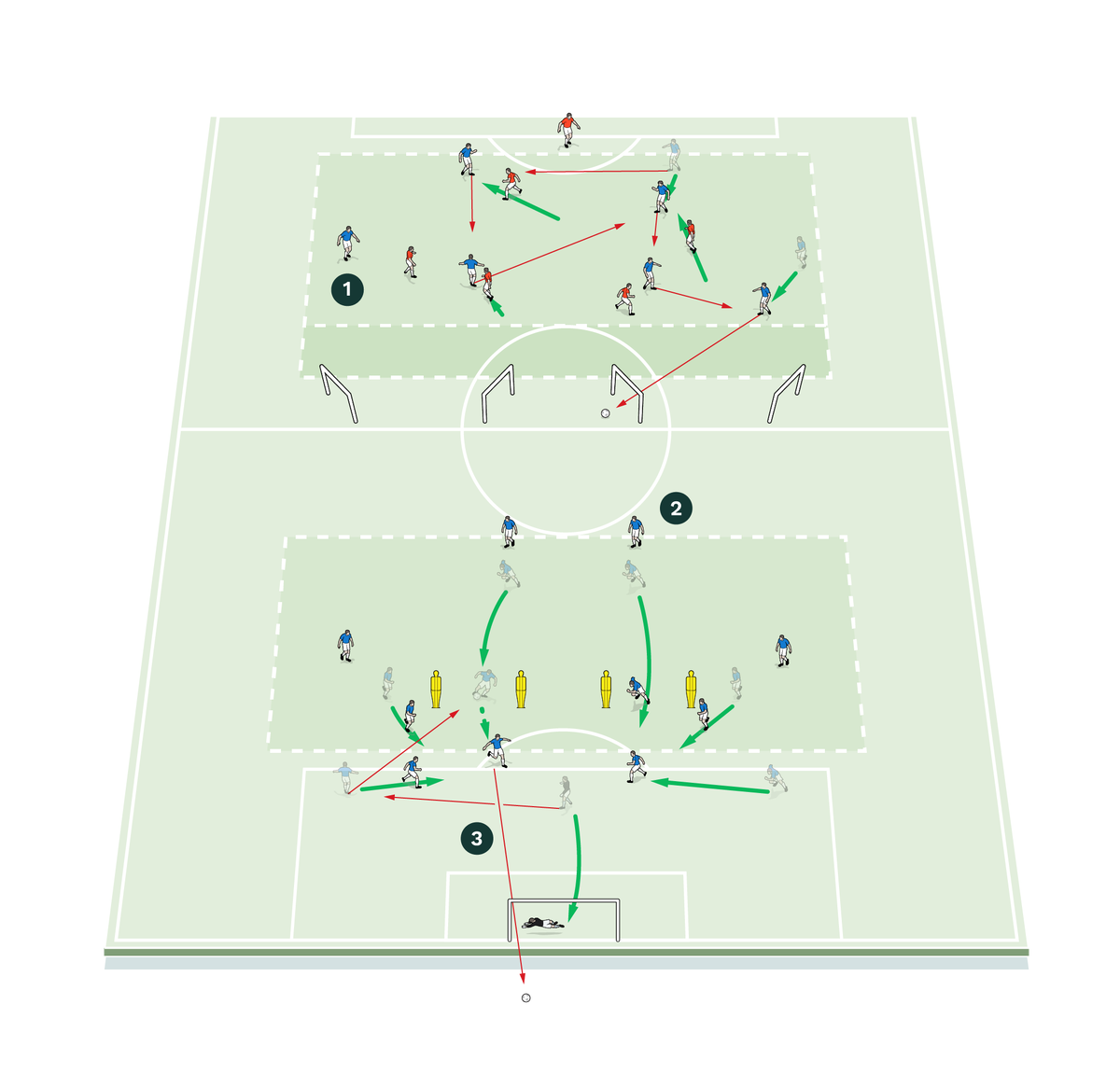
-
Eight defenders and four midfielders look for spare player to break press
-
Attacking players look to regain the ball by pressing and intercepting
-
Player seeks to score quickly past goalkeeper
DOUBLE-BOX GAME
We set up in a space the size of two penalty boxes. Six blue players plus a goalkeeper are in each box, looking to progress into the opposite box. They must play two passes before progressing, and defend the counter if they lose possession. The red team have five pressing players in each box, trying to regain the ball and score quickly, or circulate into the other box [2].
[2]

-
Reds look to progress and regain ball
-
Blues look to progress into opposite box
SPLIT PHASE OF PLAY
We set up in the full pitch. Each team has six players and a goalkeeper in their half, and build up play, trying to progress into the opposite half to create a 6v6 attacking scenario. The ball must be run into the free zone to progress [3a].
[3a]
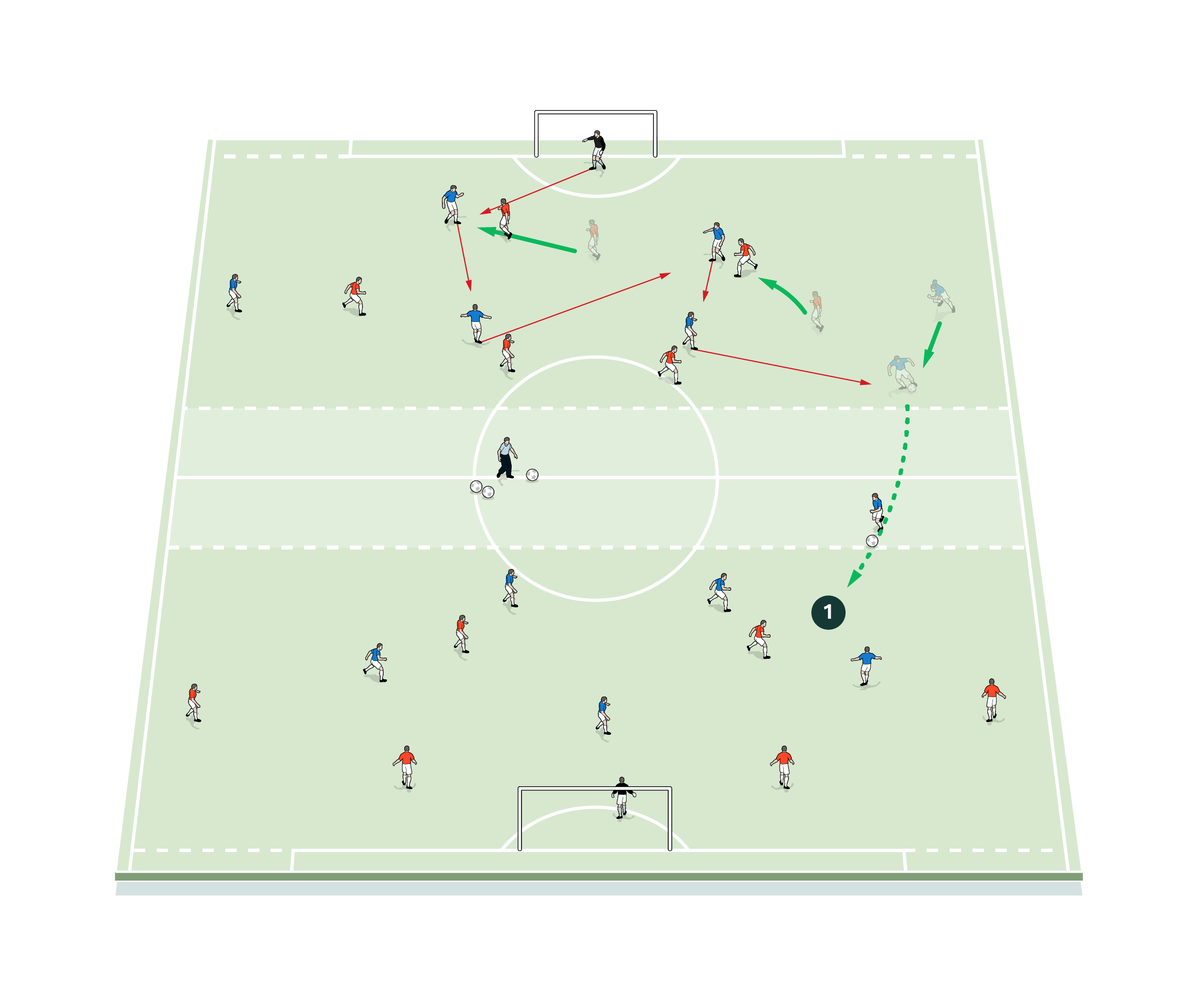
-
Blues look to progress into opposite box to create 6v6 attacking scenario
In the opposite half, each team has five pressing players, trying to regain possession and score [3b]. The coach should be positioned centrally, with balls to play in at any time for a counter-attacking transitional situation.
[3b]
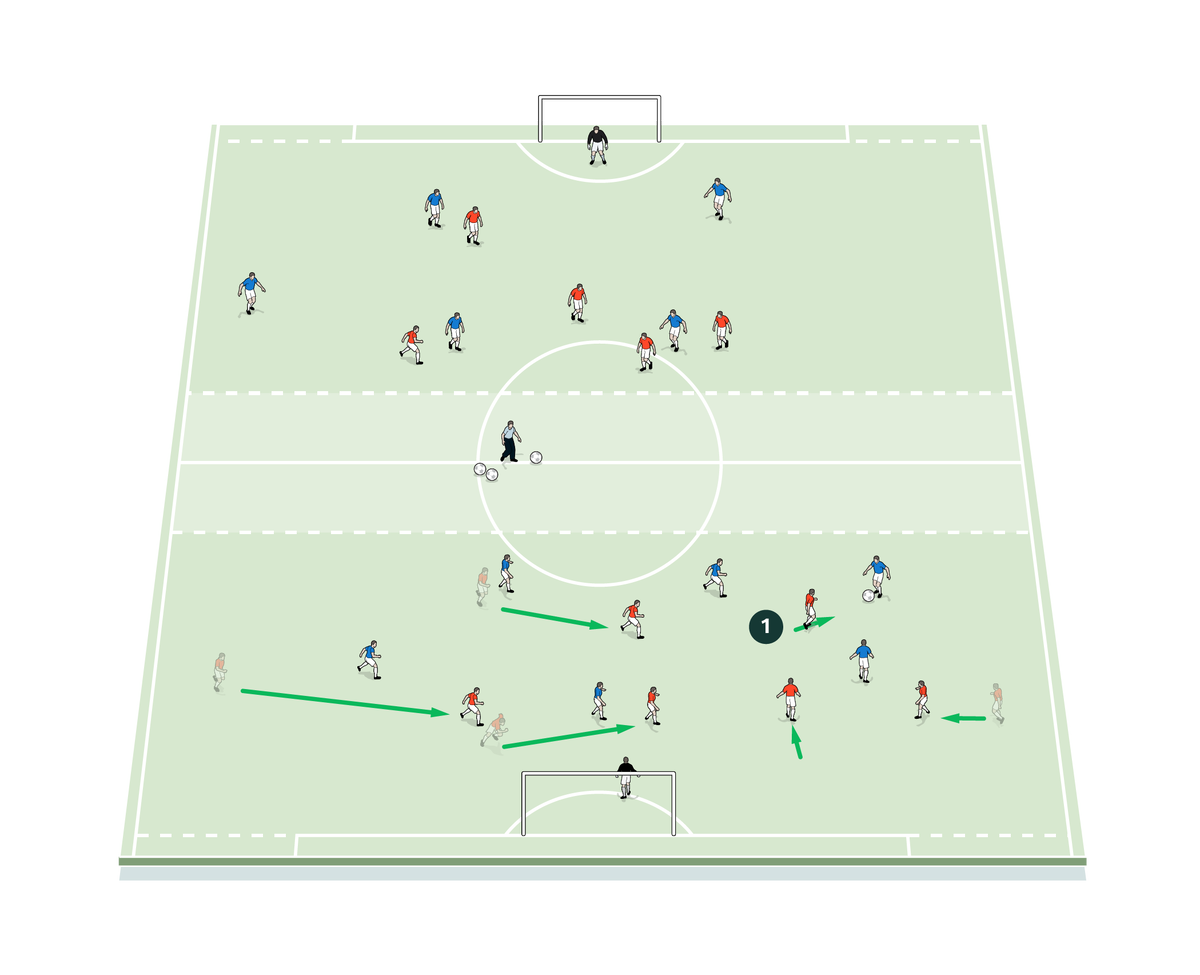
-
Red pressing players seek to regain possession and score
11v11
In our final practice, we move to an 11v11 set-up, looking to make a positive build-up to break a variety of pressing strategies. The focus should be on finding the spare player as well as drawing on individual resources to dominate 1v1 situations.
The blue team are looking to build up, and set up 4-2-2-2; the red team are pressing, and set up 4-1-4-1 [4]. Each move starts from goal kicks in the first two blocks.
[4]
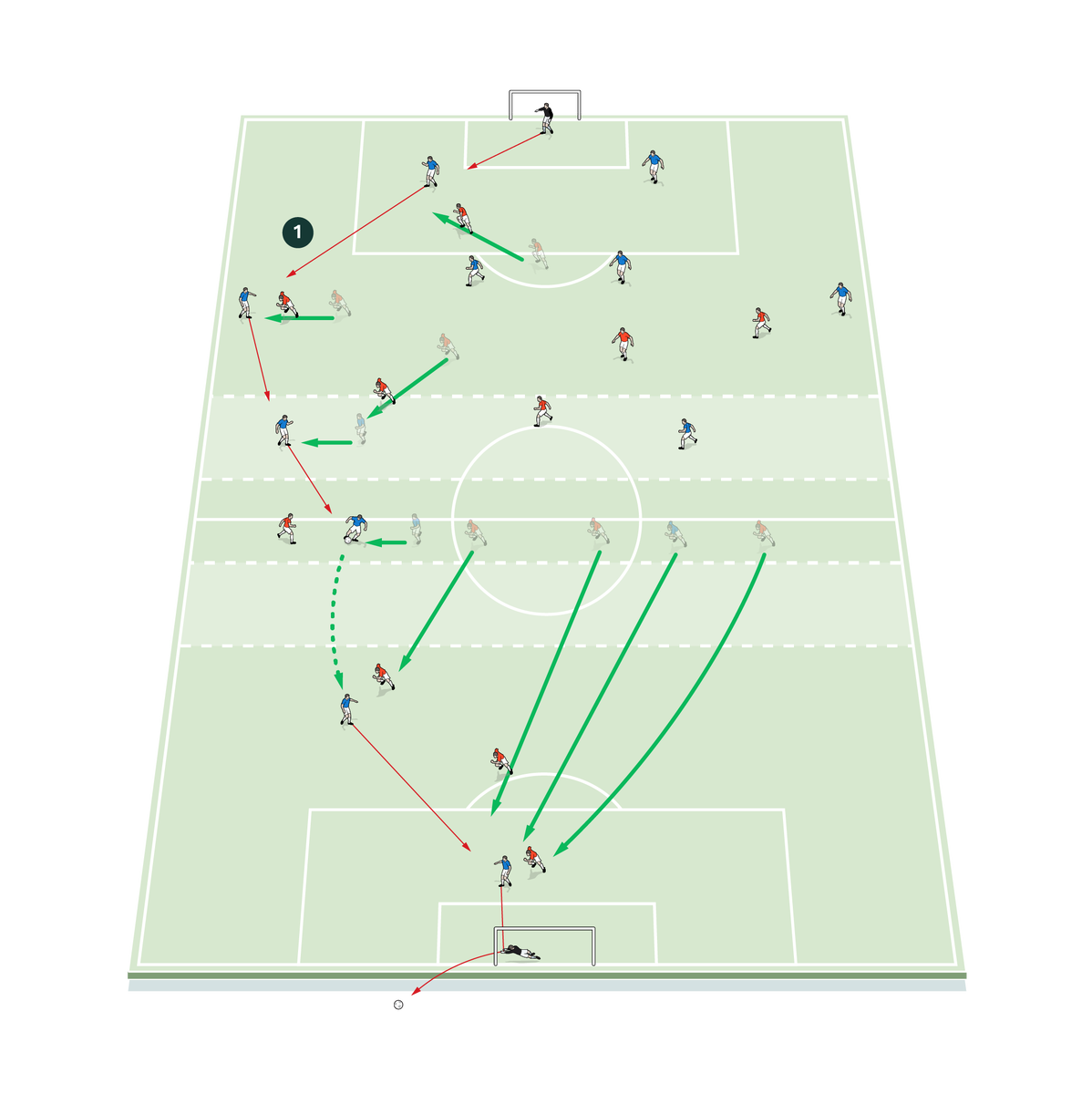
-
Blues look to build up and break the red press
You can progress this by starting outside the 18-yard box for the final two blocks of time, with the reds’ pressing shape adapting to 4-1-3-2 and then player for player in the second block. Playmakers are initially locked in the red zone. When the ball arrives in the red zone, it is free play everywhere.
You can also progress the session by operating player for player, to stretch individual offensive capabilities within the build-up and defensive capabilities within the high press. Restarts can be adapted with more second-phase balls and sometimes incorporate throw-in restarts to change the angle of approach to the build-up. Underloads can be considered, but only for short periods of time if done.
What are the key things to look out for?
Tactically: identify and search for the free player, time on the ball to create advantage, timing to arrive, only pass to the outside if there is advantage to progress, use of the goalkeeper to overload, and always create running in behind.
Technically: execution of key passes to break the press, in particular diagonal, to space (not feet) and to disguise the intention, receiving techniques, ball mastery under pressure, at speed and under fatigue, and 1v1 dominance should be a fundamental capability no matter what the collective tactical ideology.
What are the typical mistakes players might make and how do I avoid them?
Common problems include not recognising the adaptation of pressing and not identifying the free player and identifying the free players but using them too much when there is a better advantage. You can overcome this by providing immediate feedback via iPads, live clips, post-training feedback, sending players information to see at home, player modelling, and repetition of messages in every practice.
Editor's Picks
Attacking transitions
Deep runs in the final third
Using the goalkeeper in build-up play
Intensive boxes drill with goals
Penetrating the final third
Creating and finishing
My philosophy
Pressing initiation
Compact team movement
Coaches' Testimonials

Alan Pardew

Arsène Wenger

Brendan Rodgers

Carlos Carvalhal

José Mourinho

Jürgen Klopp

Pep Guardiola

Roy Hodgson

Sir Alex Ferguson

Steven Gerrard
Coaches' Testimonials

Gerald Kearney, Downtown Las Vegas Soccer Club

Paul Butler, Florida, USA

Rick Shields, Springboro, USA

Tony Green, Pierrefonds Titans, Quebec, Canada
Join the world's leading coaches and managers and discover for yourself one of the best kept secrets in coaching. No other training tool on the planet is written or read by the calibre of names you’ll find in Elite Soccer.
In a recent survey 92% of subscribers said Elite Soccer makes them more confident, 89% said it makes them a more effective coach and 91% said it makes them more inspired.
Get Monthly Inspiration
All the latest techniques and approaches
Since 2010 Elite Soccer has given subscribers exclusive insight into the training ground practices of the world’s best coaches. Published in partnership with the League Managers Association we have unparalleled access to the leading lights in the English leagues, as well as a host of international managers.
Elite Soccer exclusively features sessions written by the coaches themselves. There are no observed sessions and no sessions “in the style of”, just first-hand advice delivered direct to you from the coach.









